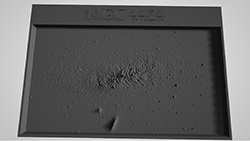CXC Home | Search | Help | Image Use Policy | Latest Images | Privacy | Accessibility | Glossary | Q&A
1
X-ray & Optical Images of NGC 4424(Credit: X-ray: NASA/CXC/Swinburne Univ. of Technology/A. Graham et al.; Optical: NASA/ESA/STScI)
Astronomers may have witnessed a smaller galaxy colliding with a larger spiral galaxy and delivering a supermassive black hole. The wide field image shows a view of the larger galaxy, called NGC 4424, in optical light from Hubble. NGC 4424 is also expected to host a supermassive black hole. The images also feature a close-up view of a star cluster, nicknamed Nikhuli, thought to remain behind after the small galaxy has had most of its stars stripped away. Optical data that has been specially processed to highlight faint features shows Nikhuli, and Chandra X-ray data gives the location of its supermassive black hole. The two supermassive black holes are likely to eventually collide and merge with each other.
2
3D Printable Files: NGC 4424 (3D Print Credit: NASA/CXC/A. Jubett, using software by Tactile Universe/N. Bonne & C. Krawczyk & Blender)
This tactile plate depicts NGC 4424, a spiral galaxy, as a physical relief map based on the intensity of the X-ray data captured by Chandra and the optical data captured by Hubble. The file for this plate can be downloaded and 3D-printed for learners to touch.
The spiral galaxy is observed from the side, making the spiral structure less evident, like observing a frisbee only from the side. The center of this galaxy, depicted by a rough patch in the center of the plate, is expected to host a large black hole estimated to contain a mass between about 60,000 and 100,000 Suns. There are also likely to be millions of stellar-mass black holes, which contain between about 5 and 30 solar masses, spread throughout the galaxy and felt as distinct points throughout the plate.
The spiral galaxy is observed from the side, making the spiral structure less evident, like observing a frisbee only from the side. The center of this galaxy, depicted by a rough patch in the center of the plate, is expected to host a large black hole estimated to contain a mass between about 60,000 and 100,000 Suns. There are also likely to be millions of stellar-mass black holes, which contain between about 5 and 30 solar masses, spread throughout the galaxy and felt as distinct points throughout the plate.
Return to: NASA Telescopes Capture Stellar Delivery Service for Black Hole (August 18, 2022)







